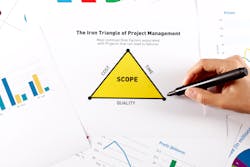This article originally appeared in the May 2022 issue of Security Business magazine. When sharing, don’t forget to mention Security Business magazine on LinkedIn and @SecBusinessMag on Twitter.
Project management is an enigma concept that many security integrators struggle with. While that may sound harsh, and I may have just lost a few readers, it is not inaccurate.
Security integrators are not alone in this very real struggle. There is a satisfaction when a project is sold – and if the sale stopped there, every integrator would be happy. Sadly, the sale is only the first step. Delivering on the sale can be rigorous and contentious. The differences and failures have been the evidence to cause infighting between sales and operations for many security integrators, from sales losing commission to the business losing overall revenue.
Successful delivery of security projects can be a stressful position for a security integrator to be in. There is a continual balance to be held between sales and operations for projects to start out and to stay successful throughout their lifecycle. A successful project must have all associated tasks laid out properly with as many associated resources as possible taken into account. From a company and management standpoint, know the pitfalls and how to avoid them. Taking these steps will set the stage for successful project management.
The Project Manager
The delivery of a project falls on the project manager. In the security industry, rarely are formally trained project managers brought in with no previous experience in the industry. While certified PMP or IC3PMs may have credentials, many of these certified individuals will understand project management methodology, but will not have the ability to “turn screws” on a security project.
This becomes a costly liability. It means that project managers must be raised up and entrusted with their first project. This new breed of homegrown project manager is set to work armed with building plans, a scope of work, and some version of a project management software, though for most this consists of a calendar. The new project manager then becomes a “windshield warrior” attempting to manage multiple projects at one time, bouncing from project site and construction meetings to the next site. While most new project managers are excited about this promotion, the realism of countless hours and impossible tasks wears thin, creating a culture of apathy and complacency.
“Despite a person’s training and experience, project management is one of the most difficult things a manager can do,” says Stewart Witt, Senior Program Manager with Exepron. “Many times, it is not the work itself, or balancing the budget, or the pressure to finish the job quickly – what makes things difficult is our inability to predict when milestones or the due date will be achieved. These things require us to make predictions, and making predictions in the complex world of projects is something that has been proven time and time again we are just not that good at.”
Project Management Methodologies
There are multiple mainstream methodologies for project management. They can all work, yet some are better than others for construction projects. The two most popular are Critical Path and Critical Chain.
Regardless of methodology, how the project is laid out is the first measure to define success. The Kanban board, or task board, or in layman’s terms, the sticky notes on the wall, will help with such things as:
- Tasks
- Stages (e.g. pending, in progress, test, complete, milestones)
- Task Dependencies (predecessors and successors of tasks)
- Resources Needed
When tasks are laid out properly, they can be managed appropriately, visualized on a Gantt chart (if needed), and by using either Critical Path or Critical Chain, can provide the project manager a clear direction of what tasks need to happen at any given time to keep the project on schedule.
Second to the tasks, the project resources – subcontractors and other trades on a job that can affect the project – should be accounted for properly. Accounting for resources can require communication with other associated trades to ensure a correct project schedule is defined. For example, if the electrician is to provide all conduits for an installation, the task shows for them to install the conduit on Monday; however, in reality, they will not get to it until the next Thursday, and now the project is already nine days overdue because the resource was not accounted for properly.
The Project Management Triangle
To be a successful project manager, success must be defined. That is where the Project Management Triangle enters, of which there are fourScope: The sold Scope of Work must be adhered to, preventing scope creep – the small concessions requested by the customer to make the project better or their lives easier. Changes to the scope without proper control and change management can affect the timeline of the project, the possible change orders and budget, or the quality in which the project is delivered.
Time: This is the timeframe provided for project completion. It could be self-imposed, or part of a larger installation project timeline. If the timeframe is unchangeable, changes can affect other elements. Any requested change request should be analyzed for impact to the overall project.
Cost: How much is this project going to cost? This becomes a bigger struggle for many integrators, because they may have limited sales adjustment options – the most used being the change order. Depending on the customer, change orders may be difficult or not accepted based on the contract.
Quality: This is the output of time, cost and scope. The quality element should be the last element affected, but many times it becomes the first element sacrificed to make up for the other elements’ shortfalls.
Pitfalls to Avoid
The picture of a project manager in the mind’s eye is David and Goliath – a kid with a sling facing a giant with so much armor he had someone else carrying some of it. While it worked out okay for David, it rarely does for the project manager.
Successful project managers need to be armed with effective tools for the job. How they choose to use them defines who they are as a project manager; however, too many times they are sent to manage projects without an appropriate knowledge transfer, proper training or the right tools to be effective. This can cost the integrator money or reputation.
“Understanding the language of the industry is incredibly valuable to a project manager,” explains Elizabeth Dunn, President of Solutions Innovation Group. “First, colleagues, stakeholders and team members feel more comfortable that you are a credible resource who will understand them and the project. That credibility and reputation can go a long way to prevent a project from going off the rails. Second, a project manager who understands their industry will be better able to find gaps, errors and omissions in the implementation plan, and develop mitigation strategies and contingency plans to keep risks from becoming issues, as well as to rapidly respond should an issue occur. Lastly, they will be in a better position to communicate clearly and effectively to all audiences.”
Pitfall: Is the PM included in the design phase? A project manager, to be effective, should be included in the design phase. This is something that again many integrators struggle with because of tight deadlines, already taxed engineering staff, and overburdened project managers. While there are many reasons as to why the project manager is not included during the design phase, costly mistakes such as unrealistic timeframes or an incomplete scope of work could be caught in advance.
Pitfall: Is the PM properly trained? Unlike the security technician, who is largely educated via on-the-job training, telephone tech support, or personal ingenuity, the project manager needs formal training. This does not necessarily require the expense of the PMP or the IC3PM certifications, although they would be beneficial. This could be the SIA Certified Security Project Manager (CSPM) or even an ad-hoc in-house training on how to be an effective project manager.
“With Project Managers under pressure to deliver on multiple projects at once, it is critical that they are well equipped with training, along with tools that improve the quality of information they receive,” says SIA CSPM instructor Chris Wilson of SiteOwl. “As projects are transitioned from sales to installation, and installation to service, Project Managers need access to data on the project, while also reducing the effort needed to compile this data. Additionally, they need real-time visibility of onsite project progress without leaving their desk.”
One costly mistake that happens with most on-the-job training encourages the PM to multitask. Multitasking is a badge that most wear with pride, though it should be worn with shame. Imagine driving a Ferrari at 180 mph (task 1) and then throwing the car in reverse while turning to the right (task 2). The outcome is that there is destruction somewhere. The human brain is the Ferrari, and multitasking will affect the quality and productivity. The concept of freezing a project – reaching a stopping point on a specific task and then turning to the next so the PM is effectively working one single task at a time – must be implemented. While the initial concept sounds counterproductive, those who master this skill can find they can manage more projects than before with better success.
Pitfall: Choosing the wrong project management software. Project management software tools can be costly, and the Return on Investment (ROI) can be difficult to calculate on its face. The return is based on optimal use of the tool to work efficiently and effectively. While tools do not do the work, proper use by the project manager help projects to be successfully managed. This repeatable outcome can provide extensive ROI.
There are two concepts to consider when deciding what tools to use: First, the right tools are not always the most expensive; and second, having the right tools does not always guarantee successful project management (although not having the right tools will guarantee unsuccessful project management).
One truth is that a calendar alone is not the right tool. Depending on the software tools, PMs may require additional technology tools as well such as tablets and laptops. Two popular software tools are Construction Management Software and Portfolio Management Software.
As cloud-hosting services have gained adoption, so too have construction management tools, which allow teaming through the design and implementation of the system. Many construction management tools incorporate design into the project management for knowledge transfer, and depending on the platform, the costs can be tied to a specific project for minimal cost. Examples of this type of platform would be Procore, Fieldwire and SiteOwl – to name a few.
Traditional project management software tools are purpose-built for managing a portfolio of multiple projects with interwoven resources and tasks. They can include very detailed Kanban boards, Gantt charts, report generation, and many are laden with integrations into other software and tools. Depending on the end-user, this type of software may be a requirement, enabling the project to be shared. Portfolio management software tends to have a much larger price tag. Examples include Microsoft Project, ConnectWise, Exepron and Primavera – to name a few.
Pitfall: Overselling that leads to apathy. Many times, the security integrator puts more emphasis and potential resources on sales. This is the flashy excitement that gets the teams rewarded, and the sales manager their salary; however, the delivery of each sale is typically a much longer process, and many times, there are not enough project managers to cover the number of projects sold.
There must be an appropriate balance between the number of projects sold and the realistic timeline and delivery of the projects. When there is not an appropriate balance, project managers feel overworked and underappreciated – all of which lead to apathy and complacency. At this point, many project managers simply stop trying. An apathetic or disgruntled project manager will rarely be successful, and a general response from management may be to push harder instead of addressing the issue of balance.
Jon Polly is the Chief Solutions Officer for ProTecht Solutions Partners www.protechtsolutionspartners.com, a security consulting company focused on smart city surveillance. Connect with him on linkedin: www.linkedin.com/in/jonpolly.
About the Author

Jon Polly
Jon Polly is the Chief Solutions Officer for ProTecht Solutions Partners (www.protechtsolutionspartners.com), , a security technology consulting firm that works with smart cities and corporations to bring business intelligence and public safety through security IoT applications. He has worked as a Project Manager and System Designer for City-Wide surveillance and Transportation camera projects in Raleigh and Charlotte, N.C.; Charleston, S.C.; and Washington, D.C. He is certified in Critical Chain Project Management (IC3PM) by the International Supply Chain Education Alliance (ISCEA). • (704) 759-6837

